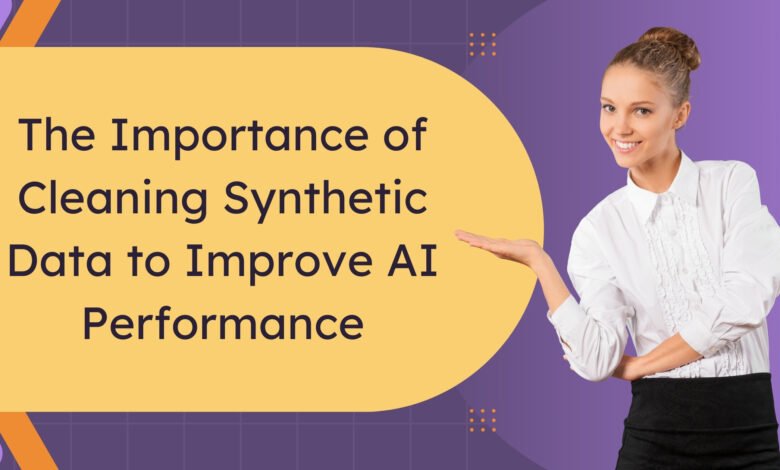
Getting accurate and relevant data is the most necessary and challenging part of building robust AI models. The performance of AI/ML depends on training data, but collecting large volumes of real-world data is complex, storing it is costly, and using the data raises concerns related to privacy and biases.
To mitigate these challenges, synthetic data has been on the rise. Gartner has even estimated that synthetic data will be used more than the actual data by 2030. But what do we mean when we call datasets synthetic? The concept is simple. It is an artificial dataset often treated as a lower-quality substitute for accurate data. Why lower quality?
Because AI generates it in any desired volume, and like anything generated by AI, its accuracy and reliability are questionable and cannot be used as it is. Synthetic data must be cleaned before being fed to AI/ML models. In this blog post, we will learn the significance of cleansing synthetic data and how it enhances AI performance.
Also Read: QuickBooks Cleanup Services for a Fresh Start?
Challenges with unclean synthetic data
While generating substantial amounts of ‘dummy’ data for AI training is appealing, it’s crucial to recognize the numerous challenges.
Limited representation of reality
Synthetic datasets may not capture the dynamic and evolving nature of real-world data. Accurate data is subject to constant changes, and synthetic datasets, being static snapshots, may not reflect the diversity and complexity of evolving real-world scenarios.
Bias and repetitiveness
AI models trained on biased or repetitive synthetic datasets may become closed systems, leading to limited and biased predictions. If the synthetic data used for training is not diverse and representative, the AI model may fail to adapt to new and unforeseen situations, potentially causing harm to users.
Note: A closed system refers to a model that is limited in adapting or generalizing beyond the data it was trained on.
Dependence on generative models
The quality of synthetic data heavily relies on the generative models used to create them. These models may excel at capturing statistical regularities but need help handling noise, adversarial perturbations, or capturing subtle nuances of inaccurate data. Using these faulty data without scrubbing leads to faulty output.
Limited contextual richness
Synthetic data may need to catch up in capturing the nuanced contextual intricacies present in real-world scenarios. This limitation becomes particularly pronounced when training models heavily depend on context, such as tasks related to natural language processing.
Significance of synthetic data cleansing
Addresses biases in synthetic data
Artificially generated data may inadvertently capture biases in the original training data or introduce new biases during the generation process. These biases can lead to skewed model predictions, reinforcing stereotypes and compromising the fairness of the AI system. Synthetic data cleansing involves thoroughly examining and correcting these biases, fostering a more inclusive and unbiased model.
Eliminates anomalies and outliers
Outliers can distort the learning process, causing models to give undue importance to rare and extreme cases that do not reflect the broader distribution of real-world data. Synthetic data cleaning by identifying and eliminating outliers ensures that models generalize well to typical scenarios, improving their robustness and performance in real-world applications.
Enhancing consistency and cohesion
Inconsistencies within synthetic data can arise from the generation process, introducing noise and hindering learning. Cleaning synthetic data involves ensuring consistency in feature distributions, relationships, and patterns. A cohesive and well-organized dataset allows the AI model to learn more effectively and generalize to unseen data.
Mitigates labeling errors
Labeling errors in synthetic data can be detrimental to the training process. Mislabeling instances can misguide the model, leading to incorrect predictions during deployment. Cleaning synthetic data involves thoroughly reviewing labels to rectify errors and ensure accurate representation, ultimately improving the model’s reliability and performance.
Improves generalization to real-world scenarios
The ultimate goal of any AI model is to perform well in real-world scenarios. Cleaning synthetic data is a crucial step in achieving this goal. The model can better generalize its learning from synthetic data to diverse and complex real-world situations by eliminating biases, anomalies, and inconsistencies.
Best practices to clean synthetic data
Understand the data generation process
Before diving into cleaning synthetic data, it’s crucial to understand the data generation process deeply. This includes knowing the algorithms and parameters used to create the artificial dataset. Understanding the generation process allows for targeted cleaning efforts that address specific issues.
Simulate real-world variability
An excellent synthetic dataset should mimic the variability and complexity of real-world data. Ensure that the synthetic data accurately represents the diversity in the actual dataset, including variations in distributions, patterns, and anomalies. This will contribute to a more robust and realistic model.
Handle missing values
A synthetic model can effectively manage a moderate amount of missing data. However, an excessive amount may pose challenges in accurately grasping the statistical structure of the data. Determine whether it’s suitable to eliminate columns or rows containing missing data or if a better approach involves filling in the gaps, utilizing methods like median replacement or techniques such as KNN imputation.
Remove duplicate records
If training records are correctly duplicated, it can hamper statistical data analysis. Additionally, many duplicated records may cause the model to perceive it as a significant learning pattern, possibly duplicating private information in the generated synthetic data.
Validate against actual data
To enhance the reliability of synthetic data, validate it against real-world data. This comparison helps identify any significant discrepancies and ensures that the synthetic dataset aligns with the characteristics of the data it aims to represent.
Bottom line
As the adoption of synthetic data continues to grow, businesses need to realize the importance of cleaning synthetic data to prepare high-quality datasets for training AI models. Nevertheless, most AI and ML companies avoid setting up an in-house team to clean synthetic data because of the time and resources associated with recruiting and training internal data professionals. In this case, outsourcing data cleansing services to a reputable company can be a cost-effective approach because of the specialized expertise, efficiency, and scalability that external data cleansing companies bring to the table, and that too at a much lower cost than an in-house team.




